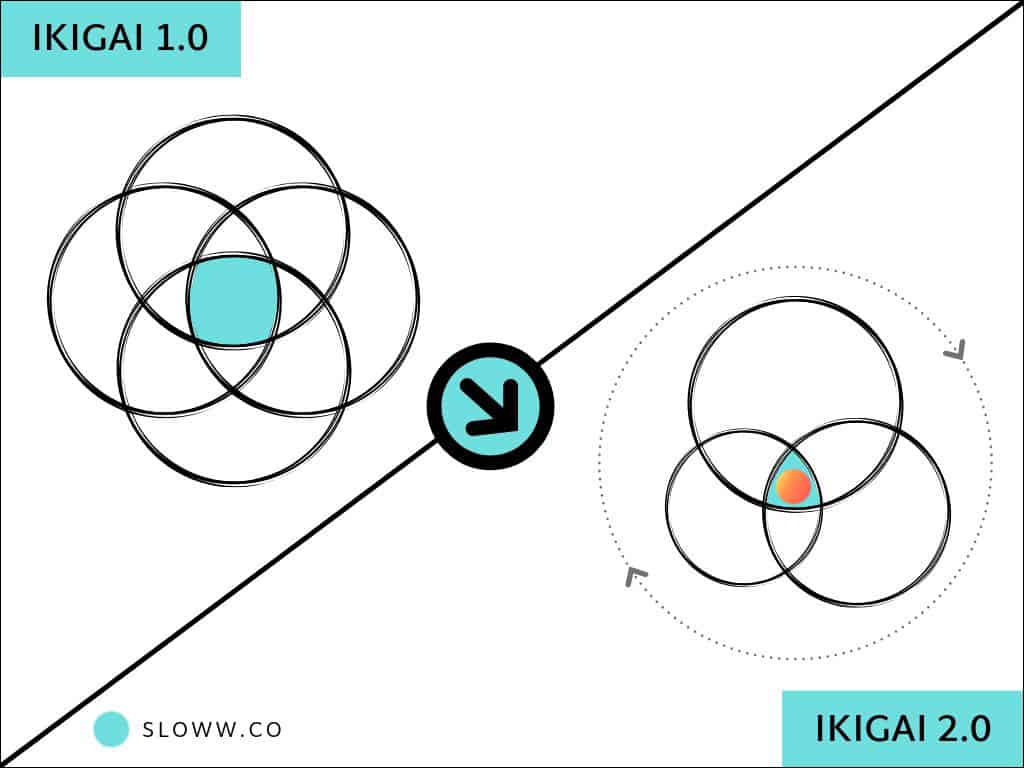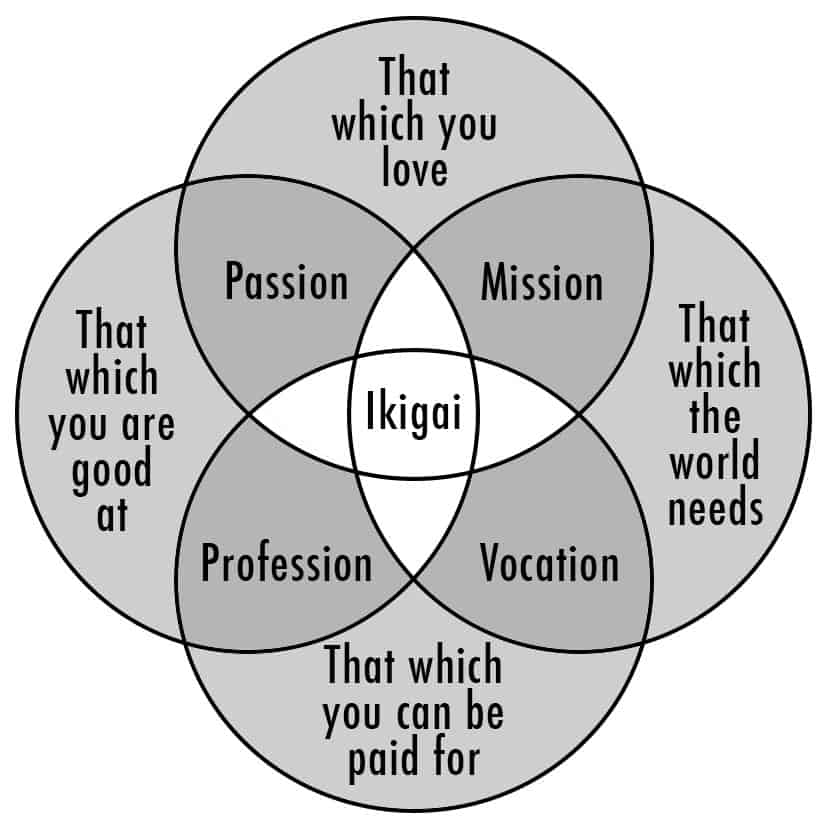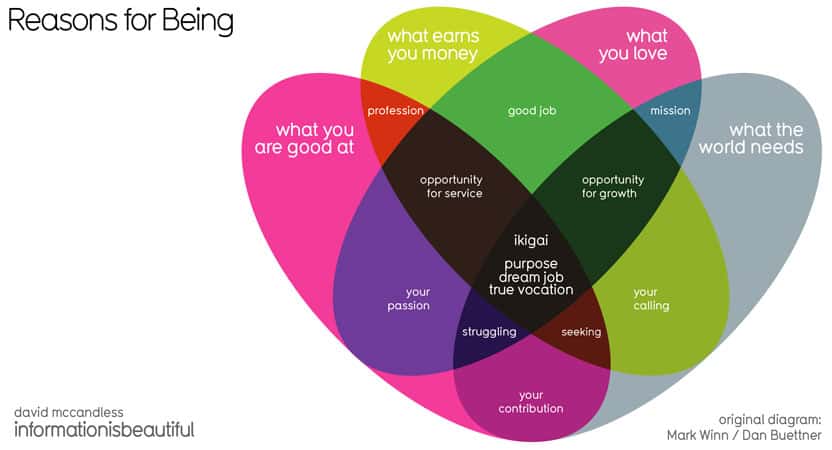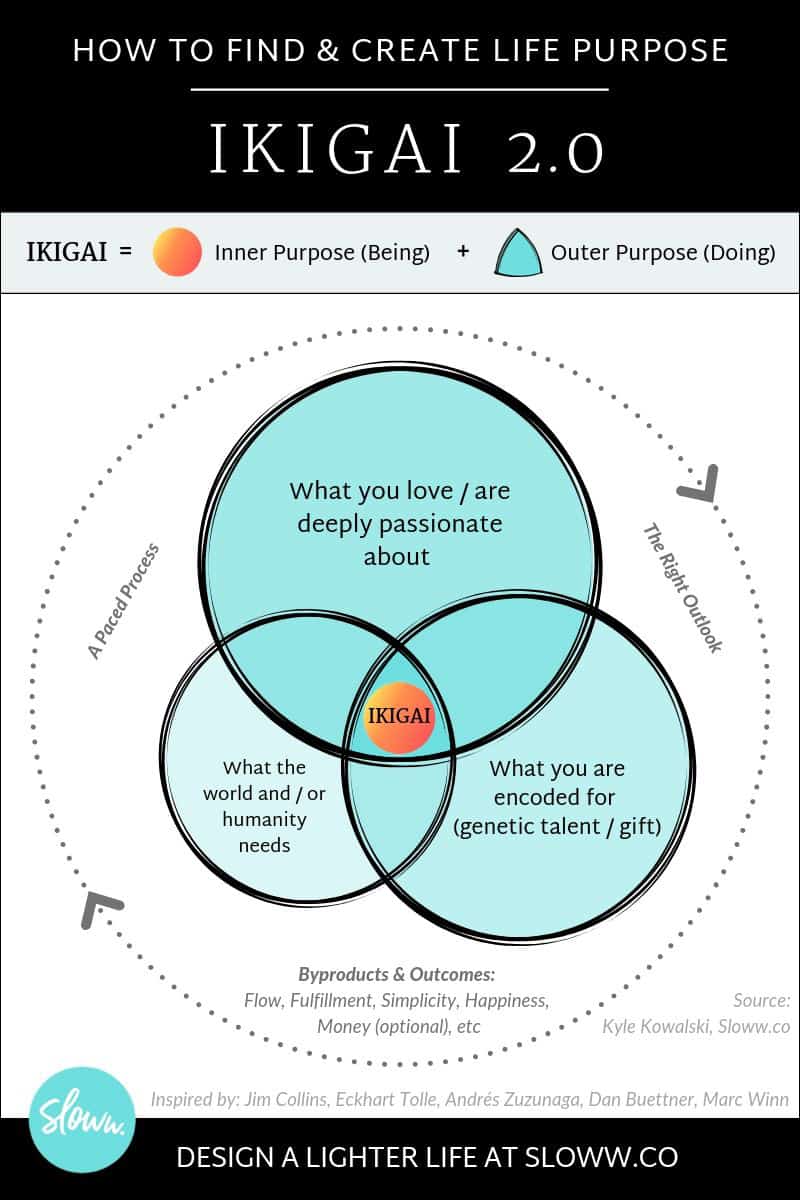This is the second post in an ikigai series. Links to the remainder of the series are listed at the bottom of this post.
Ikigai 2.0: Evolving the Ikigai Diagram for Life Purpose (& Why and How it Needs to be Redesigned)
The first post gives you the origin/definition of ikigai, the evolution of the original ikigai diagram, and busts some myths that should be considered about ikigai. It provides the basis for why the ikigai diagram needs to evolve.
This post outlines why and how I think it should be redesigned.

A Quick Ikigai Refresher:
In the first post, we learned that ikigai actually has a dual meaning. If you were to sum up the various definitions and bucket them, we could categorize them like this (paraphrased):
1. The feeling/spiritual meaning that life is worth living (being): Universal human experience, humans as spiritual beings, the joy of living, the happiness and benefit of being alive, feeling that life is valuable/worth living
2. The object/source of value in one’s life that is worth living for (doing): Things that make one’s life worthwhile, something to live for, cultivating one’s inner potential, allowing the self’s possibilities to blossom, one’s work or family or dream, the realization of what one expects and hopes for
I believe the most powerful ikigai aligns both of these:
This is the absolutely critical piece that almost all of the modern day approaches to life purpose leave out: BEING.
I recently posted a summary of Oprah’s new book The Path Made Clear where she shares inspiration and perspectives from the world’s greatest visionaries, artists, teachers, and trailblazers. Guess what she realized about all of them?
Speaking of Oprah, she helped put spiritual teacher Eckhart Tolle on the mainstream map. Tolle explains why being is primary and must come before doing. It turns out the ikigai dual meaning is exactly what Eckhart Tolle teaches:
- “The most important thing to realize is this: Your life has an inner purpose and an outer purpose. Inner purpose concerns Being and is primary. Outer purpose concerns doing and is secondary.”
- “Doing is never enough if you neglect Being. The ego knows nothing of being but believes you will eventually be saved by doing. If you are in the grip of the ego, you believe that by doing more and more you will eventually accumulate enough ‘doings’ to make yourself feel complete at some point in the future. You won’t. You will only lose yourself in doing. The entire civilization is losing itself in doing that is not rooted in Being and thus becomes futile.”
- “Your inner purpose is to awaken. It is as simple as that. You share that purpose with every other person on the planet – because it is the purpose of humanity. Your inner purpose is an essential part of the purpose of the whole, the universe and its emerging intelligence.”
- “Awakened doing is the alignment of your outer purpose (what you do) with your inner purpose (awakening and staying awake).”
Maria Popova, author of the deep-thinking blog Brain Pickings, agrees:
- “I frequently worry that being productive is the surest way to lull ourselves into a trance of passivity and busyness the greatest distraction from living, as we coast through our lives day after day, showing up for our obligations but being absent from our selves, mistaking the doing for the being.”
Keep all of this in mind as we go through the evolution of ikigai below.
Ikigai 1.0: The Original Ikigai Diagram
To help illustrate the evolution, here’s a reminder of what the original—or at least most well-known—ikigai diagram looks like (you can see the initial work to get to this diagram here):

Ikigai 1.5: The Evolution of the Ikigai Diagram to Date
I’m not the first person to propose an update the original ikigai model. I did some digging to see what else I could find.
In 2016, it looks like the Toronto Star filled in some additional blanks using an ikigai image from the stock image site Dreamstime¹:

Next, David McCandless adjusted the orientation of the original diagram to attempt to get all four circles to intersect with the following rationale:
- “Sadly, pedantically, the four-way Venn in the diagram is broken, from a technical POV. If you look closely, two sectors – love & paid for, good at & world needs – don’t intersect uniquely.”
- “So I fixed that and theorised what those missing sectors might contain, while making a few other tweaks.”²

And, the final version I’d like to share with you is from Amanda Kudo, who published a book in 2018 titled My Little Ikigai Journal. Amanda actually changes some of the circles:
- “What you can be paid for” changed to “Where I can make a difference”
- “What the world needs” changed to “How I see the world”
These two circle changes also require changes to the overlapping areas:
- “Profession” changed to “Gifts”
- “Mission” changed to “Values”
- “Vocation” changed to “Possibilities”

Ikigai 2.0: Why & How the Ikigai Diagram Needs to be Redesigned (5 Key Points)

Given that the original diagram was just a concept for life purpose and not directly related to ikigai, we should really start from scratch. We’ll leave that project for another day and instead adapt and evolve what the internet has come to know as the “ikigai diagram.”
Here are five key points outlining why and how I think the ikigai diagram needs to be updated:
This is covered in the intro of this post.
HOW: I believe this needs to be visually reflected in the center of the diagram. Being and doing must be aligned together.
I’ve never seen Dan Buettner or the Blue Zones endorse the ikigai diagram. What does the official Blue Zones site say about ikigai?
- “Individuals who understand what brings them joy and happiness tend to have what we like to call the Right Outlook. They are engulfed in activities and communities that allow them to immerse themselves in a rewarding and gratifying environment.”³
- “Do an internal inventory—think about your ideals, principles, standards and morals. Then think of your physical, emotional and mental talents, strengths and abilities.”³
HOW: We need to incorporate Right Outlook into the model. I believe talents/principles/ideals fall into the existing circles.
This is covered in more detail in the previous ikigai post if you need a refresher. Many people in Okinawa never “retire.” They perform their ikigai (or have multiple purposes) for as long as they live. Some people have an ikigai related to their family which also supports why money should be removed.
How: Remove the circle for “what you can be paid for” and show money as an optional byproduct/outcome of living your ikigai (relevant for some; not for others).
Ikigai emphasizes process, immersion, and a sense of mastery rather than an end goal.
James clear, a habits expert and author of the book Atomic Habits, says:
- “You do not rise to the level of your goals. You fall to the level of your systems.”
- “It is your commitment to the process that will determine your progress.”
The process continues forever:
- “I think life is a process. You wake up. Then you wake up some more. One self dies. Another is born. It’s an evolution of consciousness.” — Sue Monk Kidd
HOW: We need a visual element that shows that there is an ongoing process involved in ikigai.
This works two ways:
- Clockwise around the diagram: Each step is a filter for the prior circle
- Example 1: I love music (circle 1), but I’m not encoded for it (circle 2). This doesn’t work.
- Example 2: If you love something (circle 1) and are encoded for it (circle 2), this could turn to selfishness or greed if not filtered through what the world needs (circle 3). In theory, if you are doing out of alignment with being, this shouldn’t lead to a place of selfishness/greed in the first place—but circle 3 is another checkpoint here and allows you to frame what you do in context of the world/humanity.
- Counterclockwise around the diagram:
- Example 1: Being genetically encoded for something (circle 2) is not enough if you don’t love it enough to do anything with it (circle 1).
- Example 2: You can forget about what the world needs (circle 3) if you can’t even figure out what you need (circles 1/2).
HOW: Show that there is a priority order / weighting by adjusting the size of the circles accordingly and show that the process is to follow them clockwise.
I believe everything is a remix, and the best ideas build on previous ideas. Please leave a comment to let me know what you think of this evolution. What do you think of the rationale (the why & how)? How about the diagram itself?
You May Also Enjoy:
- Get the new eBook: Ikigai 2.0: A Step-by-Step Guidebook to Finding Life Purpose & Making Money Meaningfully (+ Bonus Workbook)
- The Truth about Ikigai: Definitions, Diagrams & Myths about the Japanese Life Purpose
- My Ikigai 2.0 — A Detailed Personal Ikigai Example of How to Find Your Life Purpose
- “Ikigai: The Japanese Secret to a Long and Happy Life” by Héctor García and Francesc Miralles (Book Summary)
- How the Japanese Wake Up to Joy and Purpose: “Awakening Your Ikigai” by Ken Mogi (Book Summary)
Footnotes:
- https://www.thestar.com/life/relationships/2016/09/06/why-north-americans-should-consider-dumping-age-old-retirement-pasricha.html
- https://informationisbeautiful.net/visualizations/ikigai-japanese-concept-to-enhance-work-life-sense-of-worth/
- https://www.bluezones.com/2011/08/the-right-outlook-how-finding-your-purpose-can-improve-your-life/




